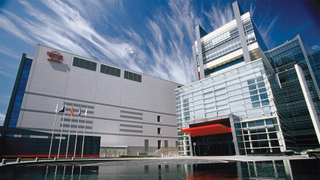TSMC’s N3E Will Reportedly Enter Production Ahead of Schedule
But do not expect many 3 nm designs shortly.

According to a Morgan Stanley report, Taiwan Semiconductor Manufacturing Co. is pulling in the production schedule for its N3E fabrication technology by about a quarter. The move will speed up the availability of numerous 3nm designs, but don’t expect many of them to be available shortly.
TSMC’s N3E node was explicitly designed to improve the process window to speed up time to yield, increase yields, boost performance, and lower power. The report says this would all be accomplished at the cost of lower transistor density compared to the original N3. Initially, TSMC expected to initiate high volume manufacturing (HVM) using N3E about a year after N3 HVM start, sometimes in Q3 2023. But since test production yields of N3E are already high, TSMC wants to start using it commercially earlier, sometimes in Q2 2023.
“Our recent checks with equipment vendors suggest that TSMC may freeze the N3E process flow sooner — by the end of this March,” the report by Morgan Stanley quoted by RetiredEngineer reads. “This means that volume production of N3E may start in in Q2 2023, around a quarter ahead of the original schedule of Q3 2023. The test production yield is much higher for N3E than N3B. Our checks suggest that the logic density of N3E is only ~8% less than that of the original N3 by cutting four EUV layers, yet it is still 60% denser than 5nm. All this makes a competitive node for TSMC in terms of cost and timing.”
TSMC’s leading-edge nodes are usually developed in close collaboration with alpha customers willing to pay extra for early access and accept certain risks, which is why these nodes are tailored for their needs. TSMC’s most important client today is Apple, but as companies like AMD, Intel, and MediaTek ramp up orders, the foundry is more willing to tailor its nodes for these customers. Apple will still likely adopt N3 ahead of everyone else.
TSMC’s N3E was never meant to replace N3, but to provide a wider choice of manufacturing parameters to achieve decent yields, performance enhancements and lower power, which will benefit all of TSMC’s customers. Given the targets, it is not surprising that TSMC and its clients are achieving faster time to yields with this technology and therefore can pull in their production schedules if it makes sense.
Even though TSMC is pulling in N3E production by a quarter, that does not mean all of its customers will adjust their schedules. Also, nothing changes for N3: TSMC is on track to start production using this node in Q3 2022 and deliver the first chips in early 2023, given long production cycles. Keeping all these facts in mind, we do not expect an influx of 3 nm-based designs (made either by TSMC using its N3/N3E nodes or Samsung Foundry at its 3GAE node) on the market earlier than in Q3 to Q4 2023.
Teradyne, a maker of test equipment for chips, recently confirmed that a significant 3 nm ramp (beyond Apple and Samsung Electronics) can be expected in 2023. While early birds could offer their 3 nm chips early in 2023, other players will still catch up with them in the second half of next year at the earliest.
Stay on the Cutting Edge
Join the experts who read Tom's Hardware for the inside track on enthusiast PC tech news — and have for over 25 years. We'll send breaking news and in-depth reviews of CPUs, GPUs, AI, maker hardware and more straight to your inbox.
“The shift to 3 nm volume production is pushed to 2023,” said Mark Jagiela, chief executive of Teradyne, at a recent conference call (via SeekingAlpha). “[…] We expect demand to accelerate again in 2023 as we begin to see the complexity growth related to investments for 3 nm, gate-all-around and advanced packaging.”

Anton Shilov is a Freelance News Writer at Tom’s Hardware US. Over the past couple of decades, he has covered everything from CPUs and GPUs to supercomputers and from modern process technologies and latest fab tools to high-tech industry trends.
Most Popular

